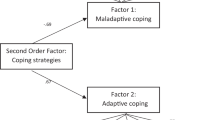Abstract
The general aim of this study is to analyze diverse aspects relating to the use of coping strategies among prison inmates. The specific objectives are (a) to analyze which type of coping strategies predominate among prisoners, considering both the focus and the method; (b) to relate the use of coping strategies with variables related to the prison environment: time spent in prison, previous convictions (first-time vs. repeat offenders) and custodial status (remand vs. convicted inmates); (c) to relate the coping strategies with the appraisal of the stressing situation previously described by the prisoners; and (d) to relate the cognitive level to the strategies used. The sample is composed of 107 males between 18 and 25 years of age in the Centre Penitenciari de Joves de Barcelona (Spain). The coping strategies were analyzed by means of the Coping Responses Inventory Adult Form (CRI-Adult; Moos, R.H. (1993). Coping Responses Inventory. CRI-Adult Form. Manual. Psychological Assessment, Resources, Inc., Odessa, FL.). The data indicate that the predominant strategies are those of cognitive approach. Likewise, it was found that there was a certain relationship between the appraisal of the problem described and the strategies used. The variables “time spent in prison” and “previous convictions” influenced the use of specific coping strategies. No connection between coping strategies and the intellectual level was found.
Similar content being viewed by others
REFERENCES
Aday, H. A. (1994). Aging in prison: A case study of new elderly offenders. Int. J. Offenders' Ther. Comp. Criminol. 38(1): 79–91.
Bandura, A. (1981). Current research and conceptualizations on stress responsivity. In Moore, C. (ed.), Adolescence and Stress. (DHHS Publication no. ADM 81-1098.) U.S. Government Printing Office, Washington, DC, pp. 99–103.
Cattell, R. B., and Cattell, A. K. S. (1977–90). Tests de Factor “g”, Escalas 2 y 3. Manual. 6a Edición Revisada. TEA Ediciones, Madrid.
Endler, N., and Parker, J. D. A. (1990). Multidimensional assessment of coping. A critical evaluation. J. Pers. Soc. Psychol. 58: 844–854.
Folkman, S., and Lazarus, R. S. (1980). An analysis of coping in a middle-aged community sample. J. Health Soc. Behav. 2: 219–239.
Gómez, R. (1998). Locus of control and avoidant coping: Direct, interactional and mediational effects on maladjustment adolescents. Pers. Individ. Differ. 24(3): 325–334.
Gullone, E., Jones, T., and Cummins, R. (2000). Coping styles and prison experience as predictors of psychological well-being in male prisoners. Psychiatry Psychol. Law 7(2): 171–181.
Jessor, R., Van Den Bos, J., Vanderryn, J., Costa, F. M., and Turbin, M. S. (1995). Protective factors in adolescent problem behavior: Moderator effects and developmental change. Dev. Psychol. 31(6): 923–933.
Jones, D. A. (1976). The Health, Risks and Imprisonment. Lexington Books, Lexington, MA.
Labouvie-Vief, G., and Diehl, M. (2000). Cognitive complexity and cognitive affective integration: Related and separate domains of adult development? Psychol. Aging 15(3): 490–504.
Lazarus, R. S., and Folkman, S. (1984). Stress, Appraisal and Coping. Springer, New York.
Livingston, K. (2000). Intelligence (IQ) as a major protective factor in resiliency in children. Dissertat. Abstr. Int. Sect. A: Humanit. Soc. Sci. 61(2-A): 496.
McCrae, R. R. (1984). Situational determinants of coping responses: Loss, threat, and challenge. J. Pers. Soc. Psychol. 46(4): 919–928.
McKay, H. B., Jaywardene, C. H., and Reedie, P. B. (1979). The Effects of Long Term Incarceration and a Proposed Strategy for Future Research. Solicitor General of Canada, Ottawa, ON.
Moos, R. H. (1993). Coping Responses Inventory. CRI-Adult Form. Manual. Psychological Assessment, Resources, Inc. Odessa, FL.
Paulus, P. B., and Dzindolet, M. T. (1993). Reactions of male and female inmates to prison confinement. Further evidence for a two-component model. Crim. Justice Behav. 20(2): 149–166.
Rokach, A. (1997). Loneliness in jail: Coping strategies. Int. J. Offenders Ther. Comp. Criminol. 41(3): 260–271.
Ruchkin, V. V., Eisemann, M., and Hägglof, B. (1999). Coping styles in delinquent adolescents and controls: The role of personality and parental rearing. J. Youth Adolesc. 28(6): 705–717.
Rutter, M. (1990). Psychosocial resilience and protective mechanisms. In Rolf, J., Masten, A. S., Cicchetti, D., Nueschterlein, K. H., and Weintraub, S., (eds), Risk and Protective Factors in the Development of Psychopathology. Cambridge University Press, UK, Cambridge, pp. 181–214.
Thies, P. A. (2000). Dissertation Abstr. Int. Sec. B: Sci. Eng. 60 Coping with HIV: A study of hiv+ male inmates in a federal prison. (9-B): 4913.
Zamble, E., and Porporino. F. J. (1988). Coping, Behavior, and Adaptation in Prison Inmates. Springer, New York.
Zamble, E., and Porporino. F. J. (1990). Coping imprisonment, and rehabilitation: Some data and their implications. Crim. Justice Behav. 17: 53–70.
Author information
Authors and Affiliations
Rights and permissions
About this article
Cite this article
Mohino, S., Kirchner, T. & Forns, M. Coping Strategies in Young Male Prisoners. Journal of Youth and Adolescence 33, 41–49 (2004). https://doi.org/10.1023/A:1027382229951
Issue Date:
DOI: https://doi.org/10.1023/A:1027382229951



